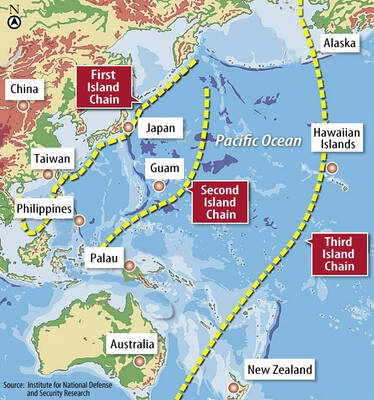The undersea lair of a giant worm that ambushed passing marine creatures 20 million years ago has been uncovered by fossil hunters.
Researchers believe the 2m-long burrow found in ancient marine sediment housed an prehistoric predator that burst out of the seabed and dragged unsuspecting animals down into its lair.
The creature may have been similar to the ferocious Bobbitt worms of today, which lie in wait in sandy seafloor burrows with antennas protruding to sense passersby.
Although soft-bodied, the worms possess sharp and powerful jaws that can slice a fish in two.
“After 20 million years, it’s not possible to say whether this was made by an ancestor of the Bobbitt worm or another predatory worm that worked in more or less the same way,” said Ludvig Lowemark, a professor at National Taiwan University’s geosciences department. “There’s huge variation in Bobbitt worm behavior, but this seems very similar to the shallow water worms that reach out, grab fish and pull them down.”
Bobbit worms, or Eunice aphroditois, take their names from the John Wayne and Lorena Bobbitt case, in which the latter — after years of physical and sexual abuse — cut off the former’s penis with a kitchen knife.
Lowemark and his colleagues discovered the fossilized lair and others like it while studying 20 million-year-old sedimentary rock on the northeastern coast.
The burrows are strengthened with mucus and are more resilient to weathering, meaning they sometimes protrude from the fine sandstone rock faces.
The research team was initially mystified by the fossils, but gradually converged on a likely suspect.
At the top of the 3cm-wide burrows they noticed a distinctive pattern that looked like several inverted funnels stacked on top of each other. This gave the opening of the lair a feathered appearance in cross-section.
Having ruled out other burrowing creatures, such as shrimp, and marks left by stingrays that blast the seabed with water jets to expose cowering prey, the scientists concluded that the feathered entrance to the lair was caused by a hunting strategy similar to the Bobbitt worm’s.
When the worms pull their prey down into their lair, the top of the burrow collapses and the worms have to rebuild it before ambushing their next meal.
“This results in the stack of cone-in-cone structures that form the ‘feathers’ around the uppermost part of the tube,” Lowemark said.
In an article in Scientific Report, the researchers describe 319 such shallow water burrows preserved in 20 million-year-old sandstone in New Taipei City’s Yehliu Geopark and on the nearby Badouzi promontory, suggesting that the local seafloor was colonized with the beasts.
The trace fossil burrows, named Pennichnus formosae, are vertical for the top meter, then run horizontal for another meter or so, perhaps because deeper sediment is harder to burrow into, and the water there is less oxygenated.
Bobbitt worms breathe by absorbing oxygen through their skin.
The researchers hoped the burrows might contain fossilized remains of prey or the worms themselves, but have found none so far.
One possible reason is that burrowing worms often inject their feces into the water and let it drift away, spreading bone fragments from past meals far and wide, Lowemark said.
Lowemark harbors a dream to one day study Bobbitt worms in the wild.
“They are impressive animals,” he said. “You don’t necessarily want to snorkel too close if you find one.”

WANG RELEASED: A police investigation showed that an organized crime group allegedly taught their clients how to pretend to be sick during medical exams Actor Darren Wang (王大陸) and 11 others were released on bail yesterday, after being questioned for allegedly dodging compulsory military service or forging documents to help others avoid serving. Wang, 33, was catapulted into stardom for his role in the coming-of-age film Our Times (我的少女時代). Lately, he has been focusing on developing his entertainment career in China. The New Taipei District Prosecutors’ Office last month began investigating an organized crime group that is allegedly helping men dodge compulsory military service using falsified documents. Police in New Taipei City Yonghe Precinct at the end of last month arrested the main suspect,

A cat named Mikan (蜜柑) has brought in revenue of more than NT$10 million (US$305,390) for the Kaohsiung MRT last year. Mikan, born on April 4, 2020, was a stray cat before being adopted by personnel of Kaohsiung MRT’s Ciaotou Sugar Refinery Station. Mikan was named after a Japanese term for mandarin orange due to his color and because he looks like an orange when curled up. He was named “station master” of Ciaotou Sugar Refinery Station in September 2020, and has since become famous. With Kaohsiung MRT’s branding, along with the release of a set of cultural and creative products, station master Mikan

Eleven people, including actor Darren Wang (王大陸), were taken into custody today for questioning regarding the evasion of compulsory military service and document forgery, the New Taipei District Prosecutors’ Office said. Eight of the people, including Wang, are suspected of evading military service, while three are suspected of forging medical documents to assist them, the report said. They are all being questioned by police and would later be transferred to the prosecutors’ office for further investigation. Three men surnamed Lee (李), Chang (張) and Lin (林) are suspected of improperly assisting conscripts in changing their military classification from “stand-by

LITTORAL REGIMENTS: The US Marine Corps is transitioning to an ‘island hopping’ strategy to counterattack Beijing’s area denial strategy The US Marine Corps (USMC) has introduced new anti-drone systems to bolster air defense in the Pacific island chain amid growing Chinese military influence in the region, The Telegraph reported on Sunday. The new Marine Air Defense Integrated System (MADIS) Mk 1 is being developed to counter “the growing menace of unmanned aerial systems,” it cited the Marine Corps as saying. China has constructed a powerful defense mechanism in the Pacific Ocean west of the first island chain by deploying weapons such as rockets, submarines and anti-ship missiles — which is part of its anti-access/area denial (A2/AD) strategy against adversaries — the